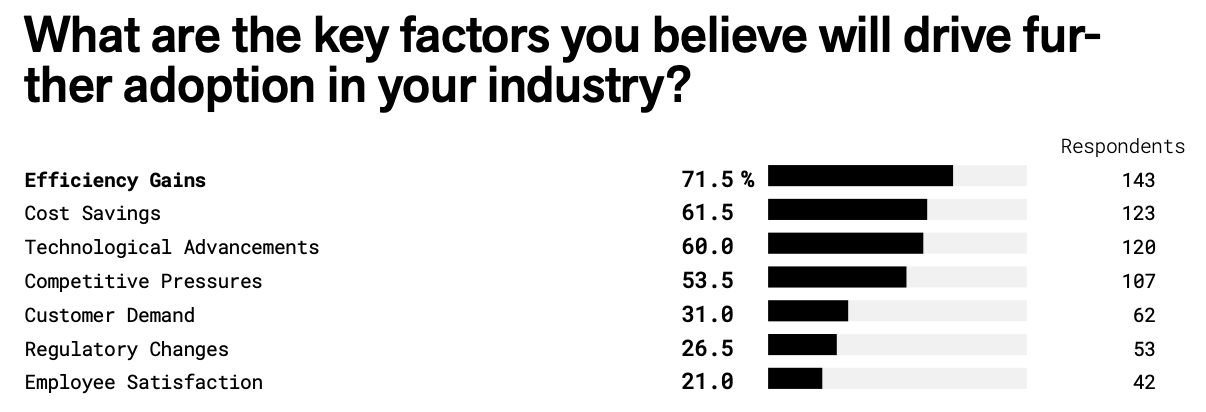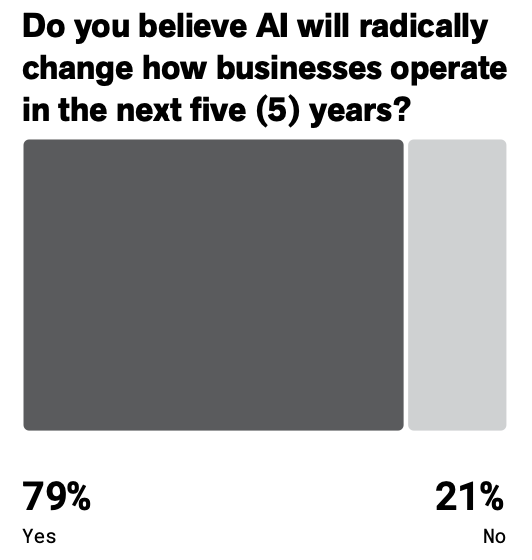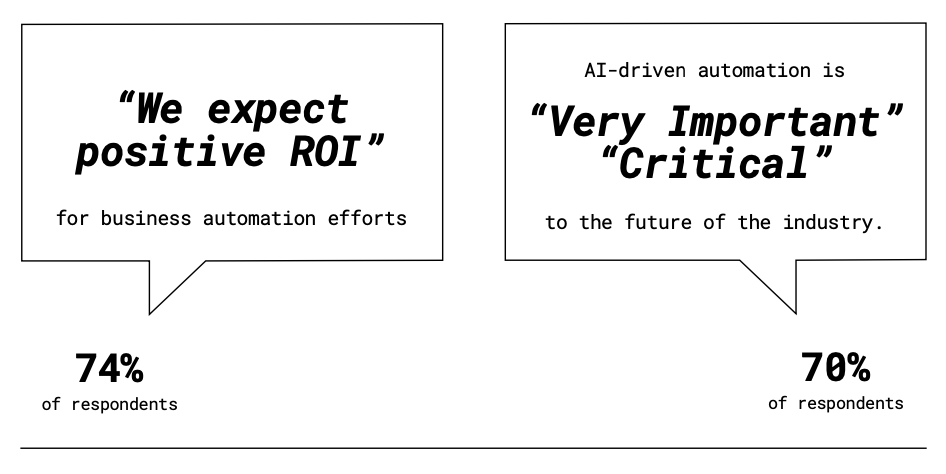Bain & Company’s five behaviors for successful AI-powered automation programs
Share at:

While many businesses spent 2023 trying to get their arms around the new possibilities unlocked by Generative AI, those that now shift their focus from theoretical possibilities to practical AI applications will gain a considerable advantage over their competitors. Yet, despite the benefits, few are doing so today.
That’s according to a recent Bain & Company report titled “The State of AI-Powered Automation,” which surveyed 200 companies to shed light on the state of AI adoption in a range of industries.

Source: Bain & Company, "The State of AI-Powered Automation"
The report, co-authored by Bain & Company employees Ted Shelton (Expert Partner) and Ian Barkin (External Advisor), identified five behaviors that successful programs tend to have in common. By understanding and applying these behaviors, your organization can harness the full potential of AI-powered automation—plus, you'll unlock meaningful business value in the process.
The five behaviors that leading AI-powered automation programs have in common
1. Process owners and SMEs lead the way in ensuring automation efforts are aligned with business goals
Nobody is closer to business processes than the employees who run them each day. While high-level direction from executives and centers of excellence (CoEs) can provide a general framework, it’s the subject matter experts (SMEs) who really drive top-tier automation programs forward.
As the authors point out in the report, “automation devoid of this expertise is akin to a ship without a compass,” and letting SMEs help guide the way “will ensure that automation efforts are not only technologically sound but also intricately aligned with the business’ unique operational fabric and objectives.”
Having recognized a clear business need for AI-powered automation, Thomas Earvolino, Director of Financial Systems and Process Improvement at Canon USA, sought to bring the technology into the company’s finance and accounting (F&A) department. Invoice processing and other tedious tasks were prone to manual errors and taking up too much of their F&A staff’s time. With a mandate from the C-suite to explore automation platforms, Earvolino talked with F&A employees to better understand what their pain points were, and the types of platforms that would be helpful. Since incoming invoices lack a standard format, they told Earvolino that a flexible solution would be ideal.

Source: Bain & Company, "The State of AI-Powered Automation"
Based on employee input, Earvolino identified the UiPath Business Automation Platform (and the UiPath Document Understanding tool in particular) as the best fit for the F&A team. Everyone is happy with the results—their backlog of invoices has disappeared, and employees are able to spend more time building relationships with dealers instead of manually keying in hundreds of invoices per day.
Today, the F&A team at Canon USA has not only automated much of the invoicing process, but has also emerged as a resource for other departments seeking to develop their own automations. This collaborative effort aligns with Canon's goal to "go beyond boundaries," as F&A team members are dedicating their automation-earned time savings to assist their peers.
Earvolino also noted that their automation efforts were “never about headcount reduction.” Rather, the goal was to find a way to “repurpose our staff to do more value-added things.” Ultimately, while executives helped facilitate Canon’s automation program, it’s been the F&A staff that have propelled it forward.
2. Success isn’t judged based on automation adoption—rather, it’s based on realizing business value in a timely fashion

Source: Bain & Company, "The State of AI-Powered Automation"
When first getting started with automation, many companies measure success based on the number of robots in production and employees using the technology. While these are important metrics to keep track of, a program should ultimately be judged on how much value it’s driving for the business.
In the Bain & Company report, the authors recommend “a rigorous validation process (often with a financial controller’s endorsement)” to ensure that the automated processes create sufficient financial value. Moreover, “before any project commences, firms must identify the value incentives the project will impact, the KPIs for outcome measurement, and a clearly defined timeline.” Doing so will allow the automation program to scale efficiently and sustainably deliver value over time.
As a decades-long industry leader and UiPath AI10 Award winner, Intel knows what it takes to realize value from new technologies. Their CEO challenged the organization to “bring AI everywhere,” which is what Jeff Rittener, Chief Trade Officer and General Manager of their International Trade Group, set out to do via the UiPath Platform.
Rittener’s group is responsible for complying with country regulations, clearing borders in a timely fashion, and engaging with governments when necessary. Intel has millions of shipments moving around the globe 24/7. At that kind of scale, any efficiency improvements mean big savings.
After a transaction form typo caused problems in their operations, Rittener decided that his group needed to pursue AI-powered automation to achieve their goal of “fingerless trade.” The typos and countless hours that come with manual transaction processing made it a fantastic automation candidate, and Rittener challenged his group to automate the process using machine learning (ML) capabilities available within the UiPath Platform.
The results were incredible. In just four months, Intel classified more than 56,000 products with over 99% accuracy. They used UiPath AI Center™ (a tool available in the UiPath Platform) and an ML model to predict codes for products that flow through their pipeline, greatly reducing the manual labor involved.
Intel plans to broaden their automation program to keep up with higher volumes and ever-changing regulations. The key takeaway is that, rather than an initial focus on spreading automation throughout the organization, Rittener and Intel first identified a workflow that would deliver significant value to the business.
Rittener joined me on stage at UiPath FORWARD VI. Watch the replay of our conversation for more details on how Intel creates and scales a successful automation program.
3. Executive buy-in is critical
Without strong executive support, automation programs “will struggle to secure requisite resources and necessary momentum and direction.”
What does this support look like? According to the Bain & Company report authors, it involves “navigating potential roadblocks, securing cross-departmental collaboration, and ensuring sustained commitment throughout the automation journey.”

Source: Bain & Company, "The State of AI-Powered Automation"
Quest Diagnostics was able to secure support from senior leadership by engaging them early in the process. Robert Steliga, Director of Business Process Automation at Quest, explained that conversations with executives during the process discovery phase helped them align on the highest-ROI automation opportunities. They also realized that a vendor with a full suite of AI-powered automation tools would help them maximize value creation.
Editor’s note: Steliga shared Quest’s automation journey at UiPath FORWARD VI. The recording is featured in Volume 2 of ‘The Best Bits’. For a limited time, get Steliga’s session and all of ‘The Best Bits’ from FORWARD VI sent directly to your inbox.
Steliga and his team determined that the UiPath Platform was the best option for Quest, and they worked with UiPath consultants to use automation to accelerate the COVID testing process during the pandemic. Executives quickly recognized the massive efficiencies that tools like UiPath Document Understanding brought to the business.
That recognition gave the team a license to explore new solutions. Steliga recounted that, “coming out of the COVID crisis, we looked back and we said, 'hey, this worked. We saved a lot of time and a lot of money. Why don't we look at this more strategically?'”
They did just that and ended up bringing new AI capabilities into their automation program.
Now, in 2023, we’ve started building custom AI and ML models using the entire UiPath Platform. This has put us in a really good position because now we have experience on the entire platform.
Robert Steliga, Director Business Process Automation, Quest Diagnostics Incorporated
While the Business Process Automation team provided the strategic direction for their automation journey, early wins helped secure executive support for a wider scope. According to Steliga, senior leadership now recognizes both the ‘hard’ benefits from automation, like direct cost savings, and the ‘soft’ kind like greater employee satisfaction and more time spent with patients.
4. Manage change holistically, ensuring that all stakeholders are on the same page
When companies first started implementing robotic process automation (RPA) technology several years ago, some encountered resistance from employees who feared for their jobs. Explaining to employees that software robots could help them do their jobs better, rather than replace them, helped achieve buy-in across organizations.

Source: Bain & Company, "The State of AI-Powered Automation"
A similar effort is necessary with AI-powered automation. The Bain & Company report authors explain that, as new technologies come to market, “employees face the uncertainties of new systems, altered job roles, and shifting responsibilities. Effective change management addresses these concerns head-on, facilitating understanding, fostering adaptability, and building collective ownership of the new direction.”
Dive deeper: How change management strategies drive automation adoption
Automation programs that don’t emphasize employee support are doomed to fail. That’s why, “in an era of rapid technological advancements, the true differentiator for successful organizations is their ability to manage change holistically, ensuring that every stakeholder is aligned, empowered, and invested in seeing automation projects through to completion.”
Since the start of their automation journey, telecommunications group Orange Spain has recognized the importance of delivering for all its stakeholders, especially employees. Javier Castellanos runs the Robot Factory within Orange Spain.
By the company's own estimates, it's saved 100 million euros since 2017.
Since starting with a team of 13 people from various business units, the Robot Factory now boasts more than 100 staff and has become widely known throughout the company. They also deploy ‘RPA ambassadors’ that work with teams across the organization to identify automation opportunities.
But while the Robot Factory enjoys strong employee support today, it was a bit rocky at the beginning.
There was concern at the start among employees that robots would be ‘stealing their jobs’ and they would be laid off. So…we made a video about this first robot deployment and how it helped the employee. And we showed it to the whole organization, highlighting clearly how software robots can help individuals be free from doing these kinds of tasks, allowing them to perform higher-value work that leverages their own talent.
Javier Castellanos, Robot Factory Head, Orange Spain
Castellanos also noted that training employees in automation “has been fundamental to the success of the initiative—on the one hand to reduce fear of the technology but also to motivate staff to change the way they operate the business.” Today, any Orange Spain employee can suggest automation ideas through the internal Robot Factory website, as well as track progress in real time.
Castellanos and Robot Factory employees have been able to keep stakeholders happy through their automation initiatives. Executives are thrilled with the significant savings unlocked by automation, while employees and customers are satisfied with the improved experiences that it’s enabled.
5. Allocate resources freed up by automation to growth areas within the organization
Many executives assume that the end goal of an automation program is driving efficiency. As report co-authors Shelton and Barkin point out, that’s just the start. Most of the ROI from AI-powered automation comes after the efficiency gains, when organizations can deploy people and investments into growth areas.

Source: Bain & Company, "The State of AI-Powered Automation"
What this means specifically depends on each company’s unique traits. In some cases, teams that save lots of time through automation continue in their same roles, and focus on more value-adding tasks within their purview. In others, businesses find that they can deliver greater value by moving employees to other areas that would benefit from their skills and creativity.
Regardless of the specifics, the Bain & Company report authors emphasize that “the human element will remain at the heart of the enterprise, even in an era dominated by AI and automation.” Their survey revealed that 64% of respondents either anticipate no workforce reductions or increased hiring after adopting AI-powered automation.
Semiconductor company Applied Materials knew from the beginning that they wanted to go big with automation. According to Heather Whitfield, Process and Test Automation Manager at Applied Materials, “we weren’t looking to save a few hours here and there, we were looking for a new toolset that changed how we work.” They concentrated their initial efforts on the finance department, which faced a formidable challenge: providing greater internal business partner support without an increase in resources. This meant that the finance team needed an automation solution to make themselves more efficient, as well as a plan to provide greater support with the time they saved.
By “going all in from day one,” Applied Materials “achieved automation success at a scale and at a speed most companies would envy,” saving more than 125,000 hours. Many organizations don’t just envy this outcome—they see it as the end goal of an automation program.

Applied Materials was different. They used the time and resource savings unlocked through the UiPath Platform to “make better, faster, smarter decisions that helped fuel growth,” as well as shift people and resources into research and development.
Early AI-powered automation adopters will have a significant advantage
These behaviors provide a blueprint for all kinds of companies to achieve real results by using automation to put AI to work. But as the report authors note, “it seems clear that AI-powered automation, including generative AI, will drive a larger wedge between those organizations that have a plan and those that don’t—amplifying advantage and placing early adopters into stronger positions during the coming market reconfiguration.”
So, to realize the maximum ROI from your AI-powered automation efforts, keep these best practices in mind and start as soon as you can. By doing so, you’ll put your organization in a great spot to succeed in the AI era.

(Previously) Chief Marketing Officer, UiPath
Get articles from automation experts in your inbox
SubscribeGet articles from automation experts in your inbox
Sign up today and we'll email you the newest articles every week.
Thank you for subscribing!
Thank you for subscribing! Each week, we'll send the best automation blog posts straight to your inbox.



